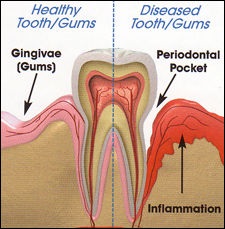 What is Periodontal (gum) Disease?
What is Periodontal (gum) Disease?
- Periodontal disease is a condition which effects the supporting structures of the teeth (gum and bone).
- It happens when irreversible destruction has occurred to these structures (gum and bone), and if left untreated can eventually lead to tooth loss.
What causes Periodontal Disease?
- The main cause of periodontal disease is dental plaque, hence the importance of the removal of plaque through brushing twice a day and by carrying out interdental cleaning of the teeth.
- Dental plaque is the sticky invisible film which grows on our teeth every day, which if left, turns into calculus/tartar (hardened plaque). The plaque contains bacteria that release harmful toxins, which can cause irreversible damage of the supporting structures.
- When the damage occurs a ‘pocket’ is formed, due to the loss of supporting structures around the tooth. As the gum disease continues, so does bone loss. When sufficient bone has been lost the tooth loosens and either falls out or is removed.
- Other factors which can cause periodontal disease include smoking, diabetes, medications (blood pressure medications), pregnancy and plaque retentive factors such as crowns/bridges which no longer fit.
How is Periodontal Disease detected?
- Your Dentist/Dental Hygienist will check the gum health by dividing your mouth into 6 areas, and gives each area a score between of 0-4.
| SCORE | What does this mean? | Treatment required |
| 0 | No bleeding
No plaque or calculus/tartar No pocket |
No treatment needed |
| 1 | Bleeding
Plaque No pocket |
Oral hygiene advice |
| 2 | Bleeding
Plaque and calculus/tartar No pocket |
Oral hygiene advice
Referral to hygienist for scaling |
| 3 | Bleeding
Plaque and calculus/tartar Plaque retentive factor Pocket measured between 3.5-5.5mm |
Oral hygiene advice
Referral to hygienist for periodontal treatment |
| 4 | Bleeding
Plaque and calculus/tartar Plaque retentive factor Pocket more than 5.5mm |
Oral hygiene advice
Referral to hygienist for periodontal treatment |
Periodontal Treatment required for patients with scores 3 and 4:
The aim of the treatment discussed below is to stabilise and prevent any further progression of the periodontal disease.
Any current damage of supporting structures of teeth cannot be regrown.
Plaque is the main cause of periodontal disease, hence the importance of its removal through excellent brushing technique and interdental cleaning technique of the patient.
Please see below the treatment plan:
| Session 1(£55- 30 min appointment):
Removal of plaque and calculus Intense oral hygiene advice – brushing technique and interdental cleaning tips |
| Session 2 (£55- 30 min appointment):
Full mouth recording of pockets – this will act as a baseline for ongoing treatment and allows the hygienist to compare results at the end of treatment Any further oral hygiene advice required |
| Session 3 (£110- 1 hour appointment):
For patients with scores of 3 – Whole mouth deeper cleaning underneath the gums using ultrasonic scaler and hand instruments For patients with scores of 4 – 1st half mouth deeper cleaning with local anaesthetic underneath the gums using ultrasonic scaler and hand instruments |
| Session 4 (£110-1 hour appointment):
For patients with scores of 4 – 2nd half mouth deeper cleaning with local anaesthetic underneath gums using ultrasonic scaler and hand instruments |
| Session 5 (£55-30 min appointment):
3 months after deeper cleaning carried out Full mouth reassessment of pockets If treatment has been successful, the patient will be placed onto the maintenance phase – hygienist appointments every 3 months and full mouth pocket recordings once per year If little or no response to treatment, referral to a specialist will be discussed |
Possible treatment side effects:
- Gum recession
- Sensitivity
- Infection
